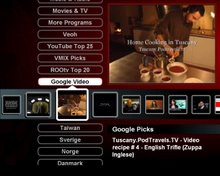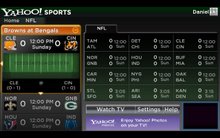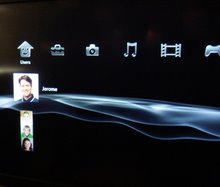The Issue: Until recently the PC has been mostly a standalone device, albeit with internet access. Falling PC and CPU prices are demanding new application for the PC which can reverse the relentless price fall.
Solutions: Support for a networked ecosystem of appliances based throughout the home is establishing a new PC platform standard, which can lead to higher valuations for PC and their component suppliers.
Behind the scene: There are several ecosystem technologies being proposed. Active-TV technology has the advantage of light-weight operation, ease of implementation and openness of accessibility.
The finance.yahoo.com chart below indicates that the Intel and AMD stock price has not grown since about year 2000. Since then it has generally been declining or appears flat. This is partly caused by what is sometimes referred to as the maturing of the PC industry. Intel and AMD are the major suppliers of the CPUs used in PCs and laptop computers. In prior years, improvements in CPU performance, architecture, system integration and fabrication technology, led to improved company fortunes. But with the maturing of the industry, a shift in the use of the PC is required to maintain growth.

With falling PC prices, or Average Selling Prices (ASP), retailers responded by offering more PC add-ons or extra devices which support PC operation. This has traditionally meant printers, extra storage or disc writers. The important shift occurring now is to sell an ecosystem of devices which interoperate in useful ways. PC industry ambitions to sell a PC attached to the living room TV have now faded. Positioning the PC as the ‘center’ of a network of home appliances has also met with very mixed success. Now the PC is being positioned by some as an equal partner in an ecosystem of mostly special-purpose appliances, such as networked Set-Top Boxes (STB), networked TVs or networked audio players.
The leaders in the PC industry know they must shift from promoting a stand-alone PC. Consequently, they are developing ecosystem solutions. The intention is to raise CPU and PC ASPs by having the PC valued in terms of its contribution to the ecosystem. Via the home network, the PC supports the operation of devices in each room of the house. Such as streaming audio to an Apple Airport Express, or even recharging the music in an iPod for use away from home.
At one time the PC industry wanted to put a PC in every home. Then Microsoft had ambitions to promote Windows in every room. But most people don’t need a PC in every room. They also don’t want the cost or maintenance of owning multiple PCs. In the US, most people who want a PC have already bought one. They may look to replace the PC if it is old or can better support an ecosystem of home appliances.
CPU manufacturers are also developing dual- and quad-core CPUs. However, the industry has never found the “killer application” that would justify the use of such impressive performance by the majority of home PC users. Yet these CPUs are expensive to make and may struggle to be sold in a way that improves the PC ASP. The solution is to apply the extra cores to support ecosystem operation. The new “killer application” turns out to be: support for ecosystem operation. A multi-core PC has plenty of performance to support traditional PC operation and assisting the operation of, say, a networked TV elsewhere in the home network.
The Intel chart below shows the relentless decline in price for Performance and Value-Segment PC markets. If PC buyers appreciate the value of higher performance, via whole-home ecosystem support, then the problem of declining ASP can be successfully dealt with.

Microsoft’s latest ecosystem approach is known as HME – Home Media Ecosystem. It first appeared with Windows Media Player 11, but it is also part of Vista. It enables a PC to serve streaming media to a network of embedded client devices. The use of HME enables Microsoft’s Windows Media Player to be a “core” software tool for managing media throughout the ecosystem.
Microsoft has tried before to build a PC-supported ecosystem using Windows Media Connect (WMC - their version of UPnP) and Extender technology (MCX), but with little success. The latest HME strategy is likely two-tier, with WMC used for lesser functionality and the Extender technology replacement, Pika (MCX v2), used for higher levels of operation. Ecosystem appliances connected via WMC support a local standalone User Interface (UI). Ecosystem members connected via Pika technology support a PC-assisted UI; This means a TV-web -like UI, formatted and distributed over the network by the PC.
Apple is building what might me described as an iTunes-based ecosystem. Networked appliances, such as Airport Express or Apple TV all connect with a PC or Mac via iTunes operation. In the case of Apple TV, some amount of standalone operation is supported, such as simple access to YouTube video. However, the more an ecosystem member is equipped to support standalone operation the more complex and costly it becomes. If an ecosystem member relies on assistance via networked support, then the cost and complexity of the ecosystem member is reduced.
Intel has been developing its ViiV ecosystem. By not being dependant on Microsoft ecosystem development plans, Intel has an opportunity to find its own solution to the complex technical and business issues relating to ecosystem adoption. Additionally, by having an ecosystem in which they retain some Intellectual Property (IP) rights may enable them to differentiate their ecosystem from another supported by AMD, assuming that any Microsoft ecosystem is made equally available to Intel and AMD.
Intel’s promotion of the home ViiV PC in support of growing amounts of digital photos, video and music, was intended to significantly contribute to addressing the decline in PC ASPs. It continues to be widely agreed that the PC’s support for consuming digital-content at the TV locations (the living room) is key to ‘growing’ the use of the PC, and possibly sparking a replacement cycle for higher-level performance and higher ASP processors. However, the ViiV TV clients still have not appeared. This has caused many to say “where is the ViiV Extended-PC ecosystem?” Without an ecosystem, ViiV is just another MCE PC. After years of development, Intel has been forced to depend on the limited functionality of the Microsoft ecosystem clients – primarily the Xbox.
ViiV ecosystem technology is much like the Microsoft ecosystem approach: They both depend on PC-assistance for delivering a TV-web -like UI. They have both shown a more PC-centric approach than the alternative active-TV technology, in that they suggest broadcast TV reception should be accomplished at the PC, rather than the networked-TV approach promoted by active-TV technology. This has technical and business-development disadvantages, which may have led to lack of ViiV ecosystem acceptance.
It will be interesting to see if Intel will revive the ViiV ecosystem or replace it. They could fall back on relying on Microsoft’s HME with MCX v2 technology. This positions the Windows Media Player (WMP) as key ecosystem application software. Alternatively, they could make more use of the Apple ecosystem and use of iTunes as a key ecosystem application.
DivX Networks has recently introduced is DivX Connected technology for ecosystem interconnect. Again, this is a PC-assisted approach. DivX is working to get its thin-client support firmware embedded into networked TVs. Of course, this is very much the strategy of the other ecosystem developers. Via DivX Connected, a networked TV can access TV-web-like formatted internet-video channels.
Except for Apple, the competing ecosystem developers make use of a common base-level of technology, such as UPnP and DLNA. Apple may have determined that consumers have generally no understanding of these technical-oriented ‘standards’; and hence promote higher-level features such as access to YouTube video. The difference between DivX Connected and the other advanced ecosystem technologies is primarily how they support advanced TV UI features via PC-assistance.
TVersity offers ecosystem-like interconnect of devices without requiring all devices be part of a homogeneous ecosystem. Because of this pragmatic approach, TVersity is not proposing a specific ecosystem technology. But, it very much adds to improved PC valuation via its ability to combine the operation of several devices – such as the Sony PSP, Xbox, networked STB and even iPhone – so as to better utilise and appreciate the new supporting role of the ecosystem-PC.
TVersity can support a PC-assisted TV UI via active-TV technology. However, the UI is by and large generated locally via micro-browser or UPnP support. A local UI usually offers less UI features or UI polish, but it works using the basic ecosystem client’s capabilities. Easy to use
 buttons are starting to appear in video sites, such as G4TV, making it simple to connect a home-networked media player with available video.
buttons are starting to appear in video sites, such as G4TV, making it simple to connect a home-networked media player with available video.AMD has posted losses for three consecutive quarters. In the fourth quarter of last year it lost US$573.8 million. In the first quarter, it was in the red US$611 million. AMD expects its quad-core processors, due out in August, to drive revenue in the second half of 2007. For this to happen it has to improve the ASP of these processors.
AMD has gained some market share from Intel, but as reported: “its average selling price fell to $75 at the end of the year from $99 at the beginning. Intel’s average selling price fell, but at a far lower rate, to $130 from $137”. Like Intel, AMD will use Extended-PC ecosystem development to address the problem. AMD’s choice has been active-TV technology, although they typically brand this as AMD LIVE! Ready.
Active-TV technology is not owned by any one company, but AMD has been a noticeable user of the technology. AMD and its collaborators have worked closely with MediaMall, a significant supplier of active-TV technology. Using its internet browser, a PC assists video-sharing sites to reach the TV in the living room. In short, all video sharing and distribution sites can be accessed via a PC. Active-TV technology extends this by delivering a TV-formatted web-accessed UI (known as TV-web) to any networked TV in the ecosystem. The PC and its browser ‘engine’ remain the standard universal platform for formatting a TV UI.
AMD used to be a second source for CPUs which were pin-compatible with Intel PC products. With the transition to its own x86 architecture a new non-compatible mother board infrastructure was required. AMD had to work closely with collaborators during this transition. Now, with the PC maturing, new industry trends and business pressures, a transition is required to a PC-platform which is the ecosystem’s engine for running web-based application. This PC-engine supports simpler ecosystem members having the benefit of web-based software.
In alignment with this new AMD and PC industry direction, BroadQ is developing is Qtv ecosystem application software. Initially intended to support BroadQ’s active-TV technology for the Sony Playstation2, this web-based application can support any active-TV enabled networked TV or Set-Top Box. From the TV UI, Qtv enables network access to photos, music and video; but it also supports access to internet-delivered videos. These different ecosystem-supporting applications, such as Qtv, iTunes, WMP and more, make use of different underlying technologies; but they are likely to see similar developments such as: support for playlist sharing, social networking, and advertising delivery.
More than any other advanced ecosystem technology, active-TV technology supports the objectives and constraints of the networked appliance developer. It is light-weight in terms of resources required or consumed, easy to embed and its openness enables access to a great deal of internet video. As much as the PC industry needs ecosystem technology to improve business, the consumer appliance industry also requires advanced support for network operation to improve its own products. Any reluctance to engage in ecosystem development will enable Apple, and the like, to attempt to fill the market holes with more offerings to follow on the success of Apple TV.
Summary: Technology companies are giving priority to supporting consumer demand for improved features offered by networked ecosystem operation. At its best, ecosystem operation can combine the best of the PC industry with the best of the entertainment appliance industry. The striving to gain a key role in any widely adopted ecosystem has led to business models and technology proposals which contain elements of exclusivity. Consequently, cross-ecosystem incompatibility is a concern for developers and consumers alike.
For a long time, the Win32 API was the standard for developing PC application software. More recently, Google and others have developed applications which don’t use the Win32 API standard but execute on-top of the popular PC browser. These web-based applications, sometimes called Web 2.0 technology, are evolving a new standard. Active-TV technology enables web-based applications to support ecosystem operation. For example, an Extended-PC assists the operation of a networked TV and enables interaction with the web-based application software at the TV UI.
Feedback, corrections and comments welcome. Contact me for more information or support with active-TV technology development.
Daniel Mann











No comments:
Post a Comment